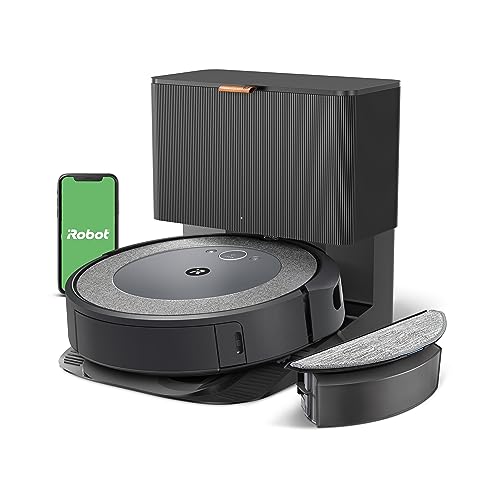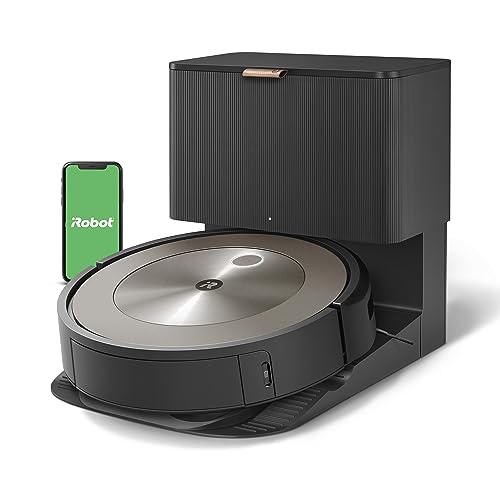How A Weekly Robotic Vacuum Cleaner Self Emptying Project Can Change Your Life
Benefits of a Robotic Vacuum Cleaner That Self-Empty
A standard robot vacuum comes with a small dust bin, which is regularly empty – ideally, after each cleaning cycle. Pet hair and other particles could clog up the system, rendering it useless.
The latest models come with docks that automatically take away debris from a bin and put it into a large storage container, like a traditional vacuum bag. Is this high-end feature worth the extra cost?
It’s not as icky.
Robot vacuums that automatically empty themselves are the best robot vacuum and mop self empty option for those suffering from allergies or who don’t like to touch dust. They can hold up to a month’s worth dirt, based on the model. This means you only have to empty it once every two weeks. This is significantly less than regular cordless robot vacuums that are available that require frequent emptying to avoid overstuffing and clogging that leads to smell, stop suctioning, or both.
The majority of robotic vacuums return to charging docks after they’ve completed their cleaning routine. Then, a second one inside the dock collects all the dust and debris from the trapdoor of the main vacuum or a bin that is located on the back or bottom of the unit. The majority of these models move this stench into a bag that is sealed off to ensure that you don’t see, touch or smell it again. The more premium models also put the mess into the reusable cup or container that you’ll only need to replace it every two months.
This feature will not help with the grimy hands you’ll have to deal. It’s a small price to pay for an easy-to-use device that will make floor cleaning easy.
If you’re looking for a non-hands-free method to keep your home tidy, a robotic vacuum cleaner with self-emptying capabilities is the most effective option on the market today. Make sure you compare prices, features and performance of different models before making a purchase.
For instance, you’ll need to check out which brands offer quick mapping before the robot begins cleaning, so that it can plan its path without you. It’ll also be important to know which models have a “quiet mode” or a DND function that allows you to shut off the sound while it’s emptying. The process can take up to a minute, so you might prefer to schedule the cleaning when you’re away from the house or away from the noise.
It’s more practical
A robotic vacuum cleaner is a great alternative for those looking for a more hands-off experience with cleaning their homes. They can be programmed to work on a schedule and many allow users to control them with an app on your phone. The self-emptying feature is an important addition to the device, allowing you to set it and forget it, while still enjoying the benefits of a clean home.
Robot vacuums usually come with a tiny dustbin that needs to be emptied after each cleaning cycle. This can be a hassle for those who don’t want to deal a dirty dust bin, or are concerned about the release of allergens into air. Self-emptying robot vacuums have the base station which holds the debris and dirt from the machine after each use. The base has a large storage capacity that can manage weeks worth of waste before it needs to be emptying which allows you to stay longer between emptying cycles, while enjoying a more hands-off experience with your vacuum.
The bigger base gives the robot vacuum a longer runtime. This means it can cover a greater area in each cleaning session. This allows you to get to all the corners, nooks and crannies which could have been missed by shorter runtimes of regular vacuums. This longer time is a major advantage for people who live in larger homes or areas with high traffic.
The self-emptying base will also aid in maintaining your robot’s its functionality. Robots are susceptible to getting caught in the crosshairs of obstacles or falling down steps, which can hinder their work and cause the area to become filthy. Some robotic vacuums have sensors that can detect these issues and adjust their settings automatically to adapt to different floor surfaces. This lets them continue to clean even if they encounter a barrier or a staircase, eliminating the need for manual intervention and giving you peace of mind knowing that your floors will remain clean throughout your home.
 The self-emptying feature of a robotic vacuum is an absolute game changer. It eliminates the requirement to empty the bin manually after each cleaning session which allows you to accomplish more throughout the day without having to interrupt your cleaning routine. If you have mobility issues or physical ailments, a self-emptying robotic vacuum is a great option because it reduces the amount of hands-on maintenance required and allows you to live a more enjoyable life.
The self-emptying feature of a robotic vacuum is an absolute game changer. It eliminates the requirement to empty the bin manually after each cleaning session which allows you to accomplish more throughout the day without having to interrupt your cleaning routine. If you have mobility issues or physical ailments, a self-emptying robotic vacuum is a great option because it reduces the amount of hands-on maintenance required and allows you to live a more enjoyable life.
It’s easier for you to keep track of
It is worth thinking about the maintenance benefits of a iRobot Roomba i4+ EVO: Ultimate Self-Emptying Robot Vacuum robotic vacuum. In the first place it can save you lots of time. It will not require you to empty your trash can often, which can get filled with debris and halt cleaning cycles. You can also utilize the machine more often. If you need to empty the trash bin multiple times per day, you may need to use the vacuum once or twice a week and could lead to an unclean home over the course of time.
Most robotic vacuum manufacturers rate the number of cleaning sessions or days worth of dirt that their devices can hold. The majority of models can keep up to 60 days or more of dirt before they require emptying. Many also come with a simple method of letting you know that it’s time to empty the canister that eliminates the need to monitor constantly of the device.
Another useful feature is the ability to create a schedule for your robot. This helps you keep your house clean, especially if your family or work obligations are taking your time. You can even set up your robot vacuum to work when you’re away. It’s like having your own personal assistant!
 If you have a large home, a robot vacuum with self-emptying base is essential. This is because you can set up your robot vacuum and then forget about it. You don’t need to constantly empty the tiny dustbin, or rely on an alert to remind you.
If you have a large home, a robot vacuum with self-emptying base is essential. This is because you can set up your robot vacuum and then forget about it. You don’t need to constantly empty the tiny dustbin, or rely on an alert to remind you.
Robots with self-emptying bases have a dock that not only charges the machine but is also connected to a variety of vacuums that pull debris from the small dustbin and then place it into a larger storage bin. It is necessary to empty out the base station every 30 or 60 days, as you would with traditional vacuum cleaners’ bags.
You can also wipe down the sensors of most robotic vacuums. They can be blocked over time by dust or pet fur. You can refer to the specific model’s manual to find out how to do this and, in most instances, it’s just the use of a microfiber cloth. If the side brushes begin to look worn-out you can replace them.
It’s more efficient
A robotic vacuum that emptys its base itself allows for longer cleaning sessions, since you don’t have to wait for it to recharge or empty the bin between cycles. This extended runtime, when combined with smart technology for navigation and mapping, allows your robot to clean wall-to-wall with no downtime or gaps in coverage.
To get the most value of your robot vacuum, you should consider an option with a big capacity for its external dustbin. The majority of manufacturers evaluate their vacuums on the basis of how much dirt they can keep. If your home is dirty often, you may prefer a model that has a capacity of up to 60 days.
It’s also worth determining if your robot vacuum of choice will automatically empty its base station once it’s empty, or if you need to manually empty the contents. Certain brands allow you to monitor your robot’s storage system via an application. This will notify you when it’s time to empty the canister.
A robot vacuum that self-empties will make some noise as it goes through the process. Mashable reporter Leah Stodart explains that this could be a bit alarming and may be quite a shock for those close to the vacuum’s operation. To minimize the impact, think about selecting one that has an option to turn off the noise and/or plan your cleaning schedule to times when you’ll be away from the house or away from household members.